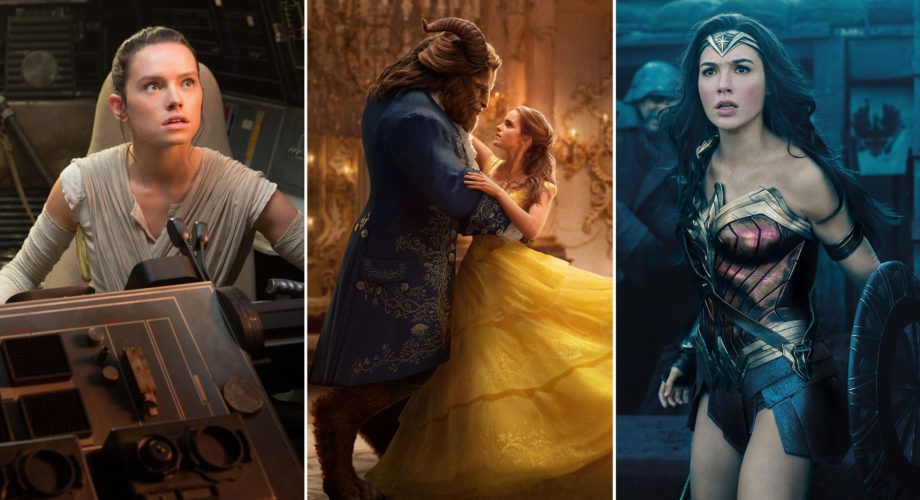
Women to the fore: Star Wars: The Last Jedi, Beauty and the Beast and Wonder Woman.
It could be seen as a fitting response to a year in which Hollywood has been rocked by sexual harassment accusations against powerful men – the three most popular movies of 2017 in North America all featured female actors in their lead roles.
Star Wars: The Last Jedi – the latest instalment of the long-running space saga – overtook Disney’s live-action Beauty and the Beast on New Year’s Eve to become the top grossing film of the year in the US and Canada, according to studio estimates.
Wonder Woman, the first world world war-set superhero tale that has so far been DC Comics’ only critical hit, came in at No 3.
The last time the top three films were fronted by women was in 1958, when South Pacific, Auntie Mame, and Cat on a Hot Tin Roof were the most popular American movies, according to box-office tracking websites.
The news comes as 300 female Hollywood actors, agents, writers, directors, producers and entertainment executives – including Natalie Portman, Emma Stone and Reese Witherspoon – kick off the new year with a coordinated effort to counter systemic sexual harassment in the entertainment business and workplaces nationwide, called Time’s Up.
The Last Jedi, which took in $533.1m, has an ensemble cast, but it has been praised for its strong and varied roles for women, including Daisy Ridley as trainee Jedi Rey and the late Carrie Fisher in her final performance as the character who made her a superstar: Princess – now General – Leia. “Female heroes are traditionally presented in cinematic isolation,” said documentary film-maker Annalise Ophelian. “This film gives us women working side by side, women in technical positions, and of course women learning the ways of the Force.”
Beauty and the Beast – a remake of the 1991 cartoon – is arguably less successful on that front. The new film, which made $504m, starred Emma Watson as the demure French beauty who falls for a monster who was once a handsome prince.
“[Belle] is absolutely a Disney princess, but she’s not a passive character – she’s in charge of her own destiny,” Watson told Vanity Fair, adding that the character had won the approval of feminist icon Gloria Steinem. But the Observer’s Wendy Ide noted that Belle “might be a feminist but she’s also kind of a dick”.
Wonder Woman – which made $412.6m – was the subject of similar debate. Patty Jenkins’ film – the highest-grossing live-action movie ever directed by a woman – was celebrated for Gal Gadot’s portrayal of the kick-ass superheroine who becomes a role model and moral example to the men pointlessly destroying each other in the trenches of Europe, and for its early scenes showing the all-female Amazons training their tough young daughters.
But Terminator director James Cameron caused a furore when he suggested that “all of the self-congratulatory back-patting Hollywood’s been doing over Wonder Woman has been so misguided. She’s an objectified icon, and it’s just male Hollywood doing the same old thing!”
Nevertheless, as the US film industry was shaken by sexual harassment accusations against Harvey Weinstein, Dustin Hoffman, Jeffrey Tambor and many others, “women were the real power brokers at the cinema in 2017,” Paul Dergarabedian of comScore, which compiles the estimated movie earnings, told the Guardian.
The Shape of Water, The Post, Three Billboards Outside Ebbing, Missouri and I, Tonya were other notable examples of female-fronted movies that made waves in 2017 and, while not necessarily enormous money-makers, may now go on to win at the Academy Awards.
“It’s a really interesting phenomenon,” Dergarabedian said. “I don’t know if it’s something in the zeitgeist that’s manifesting itself in these powerful portrayals of female characters in these really big hit movies as well as smaller indie movies.
“It is just a renaissance going on in 2017 and now moving into 2018 where female-led movies and movies with female characters at the centre of the story have moved front and centre in terms of the box office and in terms of critical acclaim.”
The media analyst said “the creative side of the business is often informed by world events … if you look at movies from the Vietnam era they have a different vibe – they are movies that reflect the culture … there’s something brewing out there and I think it’s a good thing.”
Meanwhile the top comedy of the year was Girls Trip, starring Jada Pinkett Smith and Queen Latifah, and the top film with a limited release was Greta Gerwig’s widely praised California coming-of-age story Lady Bird, starring Saoirse Ronan.
Asked if Hollywood could look at the 2017 figures in the post-Weinstein era and be confident that films made by and for women could be huge box-office successes, Dergarabedian said: “Absolutely. I think if 2017 has taught us anything it’s that women wield enormous clout at the box office and also a lot behind the camera. Hopefully one day this will not have to be something that is revelatory.”
By contrast a film closely associated with the so-called Weinstein effect – Ridley Scott’s All the Money in the World – netted a domestic total in its first week of release of only $14.7m against its $50m budget. Scott deleted all scenes featuring Kevin Spacey at an estimated cost of $10m, after the House of Cards star was accused of numerous incidents of sexual misconduct, and reshot them with Christopher Plummer in the role.
Overall, cinema ticket sales in North America were due to surpass $11bn in 2017, according to comScore’s projections, down 2.3 percentage points on last year’s record-breaking figure of $11.4bn. But worldwide they set a new record of $39.92bn.
Top five films in North America for 2017
- Star Wars: The Last Jedi: $533.1m
- Beauty and the Beast: $504m
- Wonder Woman: $412.6m
- Guardians of the Galaxy Vol. 2: $389.8m
- Spider-Man: Homecoming: $334.2m